POOL RESURFACING
Our Step by Step Pool Resurfacing Process
Areas We Serve
Pool Resurfacing FAQs
What is the best pool resurfacing material?
This is often a topic of debate but is best answered subjectively. Here are some of the common resurfacing materials and the advantages of using them.
1. Plaster
Plasters are one of the most common materials used in swimming pool resurfacing. It often comes in white, but can be had in various color options. Made from Portland cement and aggregate, plaster is the cheapest resurfacing material available and will last an average of 7 years in a maintained environment.
2. Pebble
Pebble is similar to plaster with the main difference being its choice of aggregate material. That said, pebble finish is often more durable and can last for 15-20 years on average. There are also specialized pebble finishes that boast better durability and longevity. Because of its added benefit, pebble finishes are more expensive than plaster.
3. Quartz
Quartz finishes also boast better durability compared to the average white or colored plaster. Instead of using pebbles, quartz is added to cement giving your pool a unique look. Quartz finishes often last for more than 15-20 years on average (just like a pebble finish).
That said, if longevity and durability are what you’re after, pool finishes with quartz and pebble can be considered the best option. However, if you’re working with a limited budget, the more-affordable white plaster will prove to be a better choice.
How often does a pool need to be when using basic plaster?
The average pool plaster lasts for about 7 years. That said, it’s common practice for pool owners to resurface their pools every 7 years. However, in conditions where the pool is not properly maintained, manifestations of wear and tear may appear before the 7-year mark. Aesthetic damages like stains and smears, as well as more pressing issues like signs of cracks and other structural damage, should call for an inspection and a visit from your pool professional. Furthermore, tell-tale signs like unexplainable loss of water as well as the exposure of concrete underneath will require the pool to be resurfaced.
What is the longest-lasting pool finish?
One of the longest-lasting pool finishes used in an in-ground concrete pool is pebble. It is also the least expensive over time when properly cared for and maintained. A pebble pool finish can last an average of 15 – 20 years under ideal conditions and will require very little maintenance since it suffers less noticeable cosmetic issues compared to basic plaster. While there are various kinds of pool finishes that boast of longevity and reliability, a good pebble finish makes for a practical choice for those looking for the perfect balance of a low-maintenance and hard-wearing pool finish.
Can you resurface a pool yourself?
Yes, you can definitely resurface a pool by yourself. You can search online for various DIY project tutorials about swimming pool resurfacing. However, unless you know what you’re doing, it’s suggested that you leave this undertaking to the professionals. That said if you’re on the fence about resurfacing your swimming pool on your own or if you should hire a contractor, here are some of the pros and cons of DIY swimming pool resurfacing.
Pros:
- Saves you money from professional fees.
- You can opt for cheaper raw materials.
- It can be an immersive project.
Cons:
- It requires time, effort, and proper planning.
- Mistakes can be expensive.
You are not discouraged to take on a DIY pool resurfacing project. However, considering that hiring a pool contractor or a pool professional can help save you time and energy in cleaning as well as construction, hiring professional pool services is strongly suggested. Asking help from a professional also gives you the added benefit of inclusive inspection, professional-quality resurfacing, the use of heavy-duty pneumatic and precision tools, and a guarantee on workmanship.
What is the difference between resurfacing and replastering?
There is no difference as both generally mean removing the current surface of the pool and applying a new surface (generally plaster or pebble). The words are used interchangeably in the pool industry. “Pool remodeling” generally implies a larger scope of work than just replastering, and may include such things as new tile, lights, coping, and equipment.
If you’re thinking about resurfacing your swimming pool in Calabasas or in Westlake Village amongst a plethora of other areas, Valley Pool Plaster is ready to help you through the entire process. We know you have a lot of choices when it comes to pool resurfacing service, but we hope you’ll agree that the quality of our work and our customer service are among the best in the industry. We strive to ensure that every customer is satisfied and pride ourselves on being accessible whenever any of our customers have a question or concern about their pool resurfacing project.
There are a variety of materials that can be used in pool resurfacing service. The cost of resurfacing pools varies according to the medium that is used. The least expensive option is to recoat your pool using an epoxy paint, but bear in mind that this is essentially a band-aid—a temporary solution that would allow you to save for one of the following more permanent options:
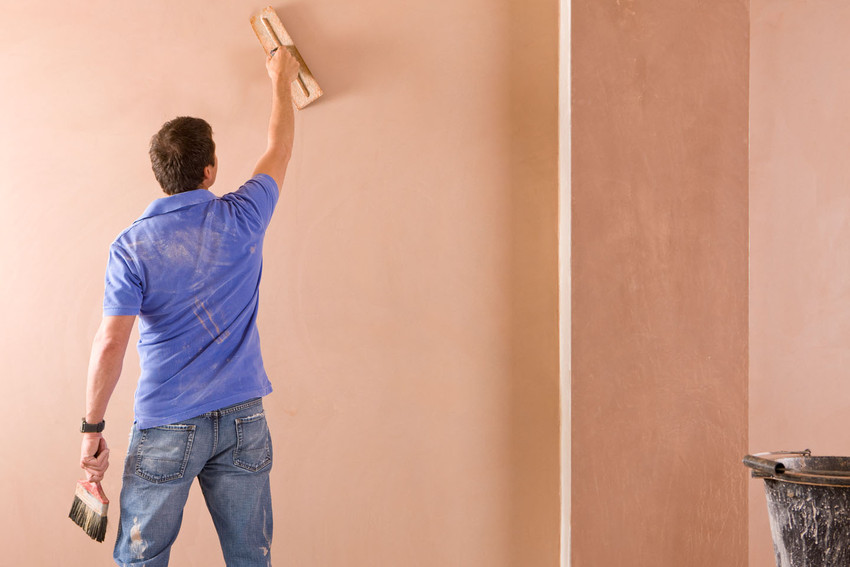
Pool Plaster
This is probably the most commonly chosen swimming pool resurfacing option. Plaster is relatively an inexpensive option that is also fairly durable. Plaster gives a classic, clean look and is available in different colors. It is more susceptible to staining than more expensive swimming pool resurfacing finishes like quartz and pebble.
Aggregate
Plaster that has been mixed with small pieces of quartz, granite, river stones, or glass beads is the trendiest new swimming pool resurfacing option. It is both attractive and long-lasting, and it is more resistant to chemicals and staining than regular plaster finishes. Aggregate finishes tend to be pricier than other options and are more textured than a smooth plaster finish.
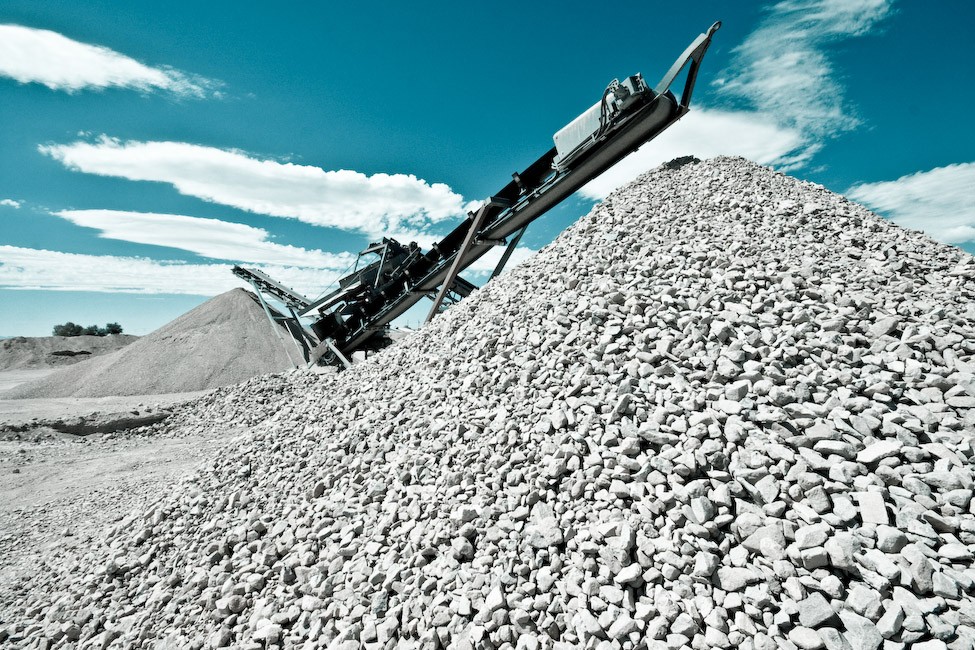
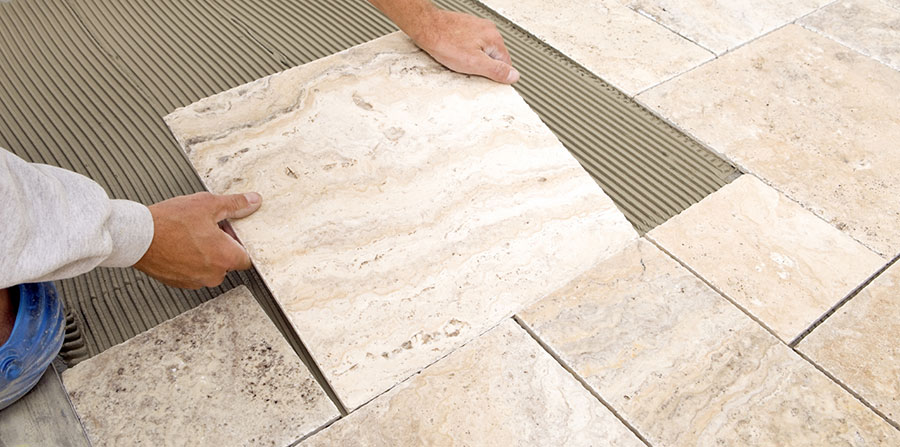
Pool Tiles
A final option for resurfacing your pool is to use tile. While this can be artistic and beautiful, it is the most expensive option in pool resurfacing services due to both the labor and materials involved. Intricate custom designs can be created and used to accent other finishes or to cover the entire pool surface. Material options range from ceramic and porcelain to glass and stone tiles. They come in a vast array of shapes, styles, colors, and sizes, allowing for virtually endless combinations and designs.
Everything You Need To Know About Pool Resurfacing
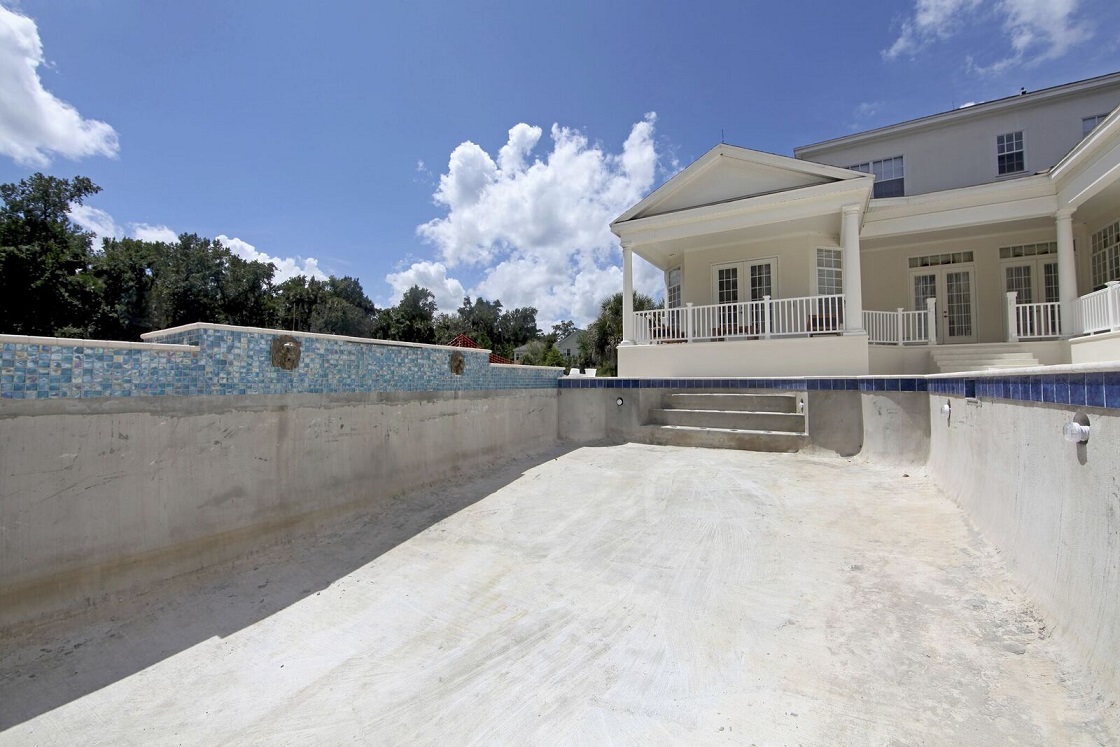
Your pool has been a lifelong friend.
It’s been the site of many parties. The children have taken their first swimming lessons there. And who can forget those calm evenings spent by the poolside, drink in hand, just waiting for the darkness to settle?
Yet if a pool has been serving for many years, it’s likely its aging process has already begun. Discolorations, cracks, and blisters are some common signs that your pool is in urgent need of a resurfacing job.
This is a task for the pool remodeling, pool resurfacing or pool plastering service professionals, and it’s best to call in qualified experts with a proven track record. However, for any homeowner, knowing some of the resurfacing basics can come in handy.
So here it is: the ultimate guide to pool resurfacing that tells everything there is to know from the ground up.
What Is Pool Resurfacing
Swimming pools can prove to be a great source of recreation and relaxation for the entire family for years on end. Like everything, however, pools wear out with time. The sides and bottom of pools begin to chip away, cracks start to appear, and soon they may even develop leaks.
In such situations, it’s best to resurface the pool, which essentially means applying a new surface coating. A correctly done resurfacing job can help a pool recover from early symptoms of aging, and give it a new lease of life.
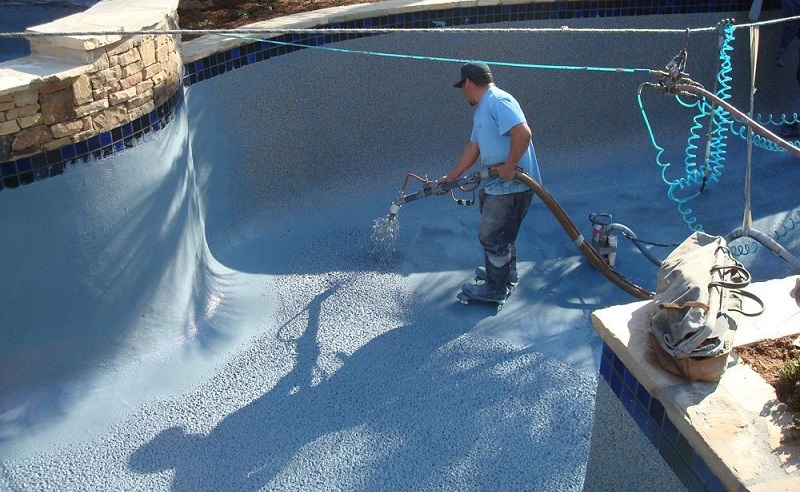
But pool resurfacing requires a significant amount of preparation and should not be taken as a simple task. The first thing to know is the kind of surface that is already present in the pool.
Often this is a bit difficult to understand, but we’re here to help out. Typically, pools are constructed in any one of the following three ways:
- In-ground concrete pools.
- Fiberglass drop in pools.
- Vinyl liner pools.
Based on the type of pool currently in use, the requirements for pool resurfacing will vary. The existing pool surface needs to be prepared for accepting the new surface coating. But how to recognize whether your pool needs resurfacing?
That’s precisely the topic of our next section.
How To Tell If A Pool Needs Resurfacing?
Pool resurfacing is not an activity that should be undertaken on a whim. In fact, it’s very unlikely that a pool will need to be resurfaced before at least five years of use. The frequency of pool resurfacing depends on the level of maintenance that the pool has seen. To some extent, even the chemical composition of the pool water determines the surface longevity.
A pool doesn’t require a resurfacing overnight, and it’s only after years of service that the first signs of aging begin to appear. The following are some of the signs that foretell a resurfacing requirement.
- Sudden leaks are appearing in the pool.
- Uneven pool surface texture.
- Stains that become increasingly difficult to remove.
- An excessive number of cracks.
- Plaster that is peeling off the walls.
- Pebbles becoming loose and dislodged.
The above are some of the most prominent signs that scream out for resurfacing. The problem is that some property owners neglect these signs and delay with resurfacing out of cost concerns. This is a grave mistake, as neglect always results in greater costs in the long run.
Types Of Pool Surfaces
When thinking about resurfacing a pool, it’s important to know the various types of surfaces that can be used. The following is a list of the most common pool surfaces that are usually used. Keep in mind that choosing the pool surface type is a matter of personal choice and budget.
1. Plaster Surface
Pools that are made of gunite are usually surfaced with pool plaster, which is a simple mixture of cement with limestone sand. This kind of surface is typically the least expensive and can give a lasting service for five to seven years.
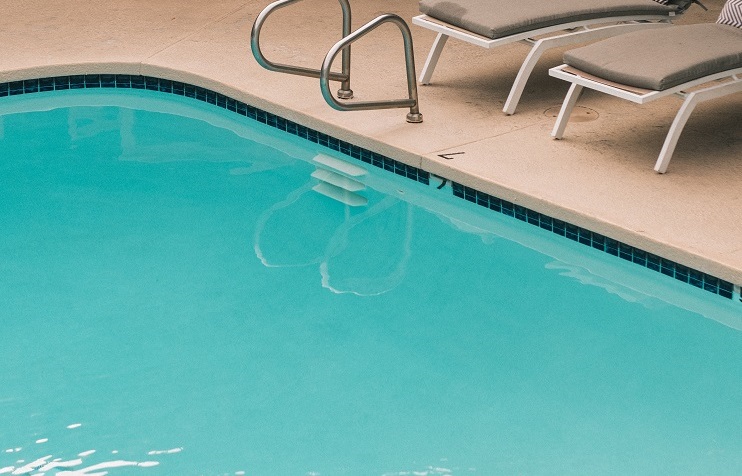
2. Pebble Surface
This is nothing but plaster with stone aggregates mixed in order to make the surface resistant to stains. It also makes the surface more robust and prevents untimely wear and tear. Remember, pebble finishes can leave a pool surface somewhat rough; however the upside is that they last twice as long as simple plaster finishes.
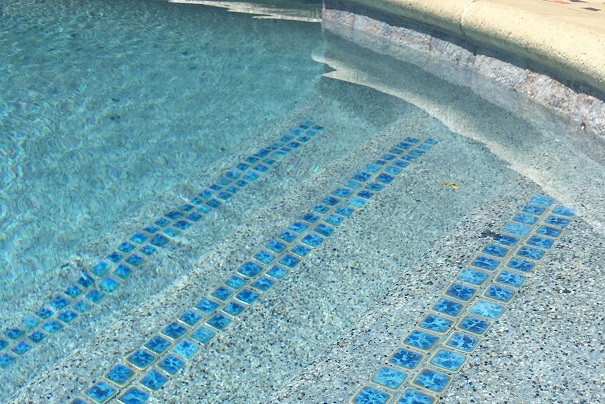
3. Quartz Surface
This, again, is plaster mixed with a quartz aggregate. Here, the quartz imparts a particular color to the pool surface and is much more stain-resistant than a regular plaster finish. It also lasts anywhere between eleven to fifteen years.
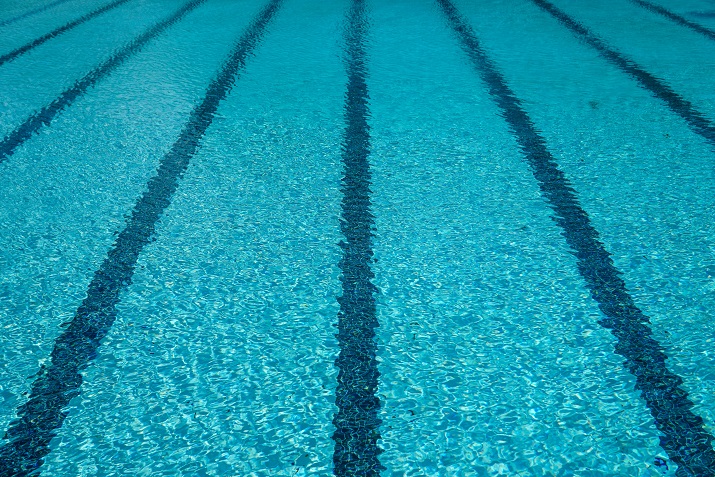
4. Fiberglass
A fiberglass surface is more appropriate for pools that are constructed entirely of fiberglass, and naturally cost more than the other kinds of pool surfaces. But they are also more durable, and so the tradeoff is a reasonable one.
With the above information in mind, let’s take a look at the entire process of pool resurfacing.
The Pool Resurfacing Process In Easy Steps
1. Cleaning & Draining The Pool
As always, the resurfacing process begins by cleaning and draining the pool. For draining your pool, experts are going to use a submersible pump. This should be followed by turning off all the pool equipment, and then the pool should be cleaned with a wire brush.
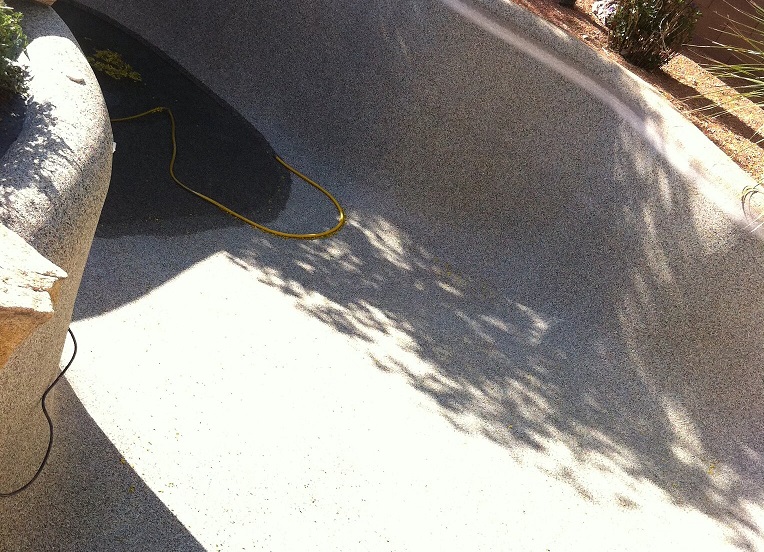
2. Removal Of Surface Material
This is the second step of the resurfacing process and is usually the loudest and dustiest of the entire lot. This step incorporates pneumatic chisels and hammers to strip the old surface. The purpose of this step is to remove the old surface materials and prepare the pool to receive the new coating.
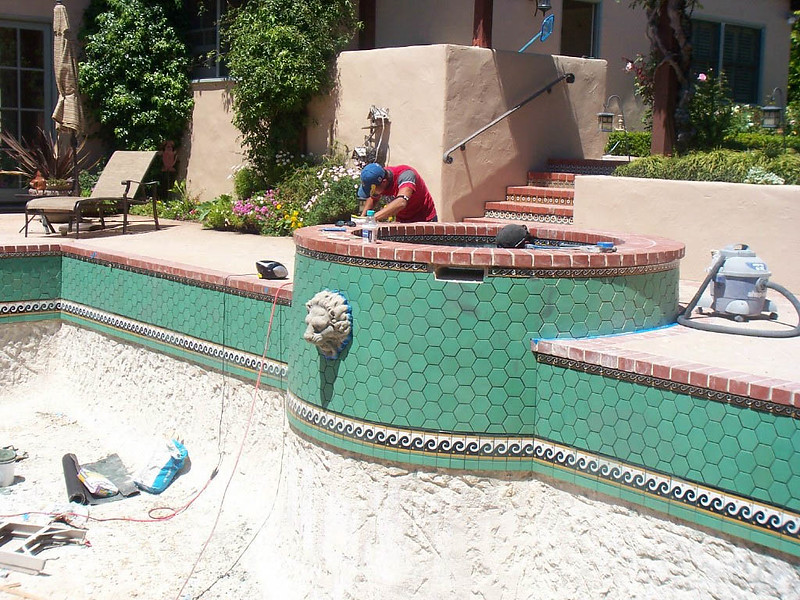
In this step, make sure that the experts working on the pool take the necessary precautions to protect your property. Also, take care to remove any poolside furniture to prevent damage. Don’t forget to make sure that the contractor cleans up after the process is complete.
3. Tiling The Surface
Now it’s time for tiling the surface. This is a step where you can get creative and choose the kind of surface that the pool should have. After the surface type and tiles have been selected, the masonry experts can begin. Apart from tiles, this is the step where any coping and decorative material should be installed.
Any other requirements and suggestions that the homeowners might have can also be incorporated in this step.
4. Sealing The Plumbing
Once the tiling and surfacing have been completed to satisfaction, now it’s time to make the pool watertight. This is done by sealing all the plumbing and making sure that the pool does not develop any leaks. Also, the pool should be washed at this stage to prepare it for the final pool finish.
5. Application Of Pool Finish
This is the step where your chosen pool finish is actually applied to the pool. This step takes about half a day to complete. The time taken to finish depends on a number of factors, most important among them being the pool size, and the type of finish applied.
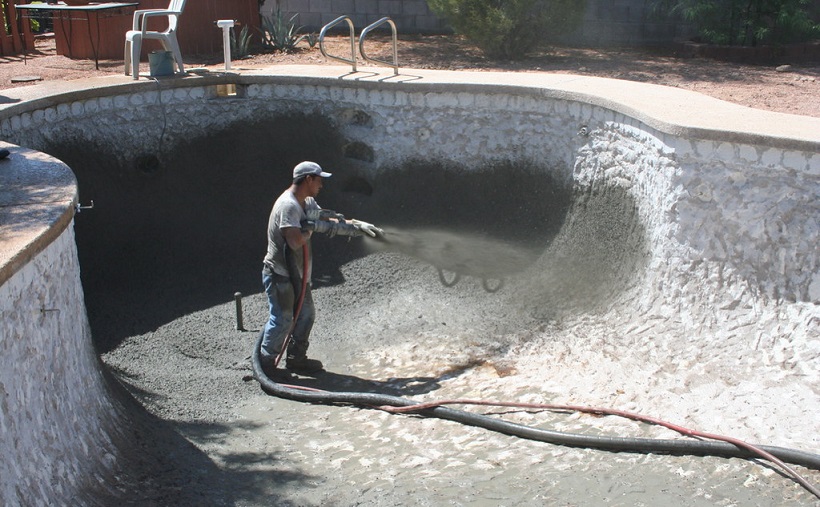
6. Optional Acid Wash
This depends on the type of pool finish that is used. An acid wash is mostly required if you have selected quartz, hydrazzo, or pebble finish, and is used for removing any rough or uneven surfaces. This is a step that requires a careful operation and must be handled only by experts. So make sure to hire only trained and certified professionals to do the job.
7. Filling The Pool
After the acid wash, now it’s time to refill the pool. It’s best if the homeowners are present for this step, as they can help keep the water level in check while the pool is filled. This is a must if you wish to avoid water lines forming on the sides of the pool. It’s important to not turn off the water completely at any point while filling the pool for the first time. You can slow down the rate at which it fills, but don’t turn it completely off until it reaches a few inches above where the tile meets the surface.
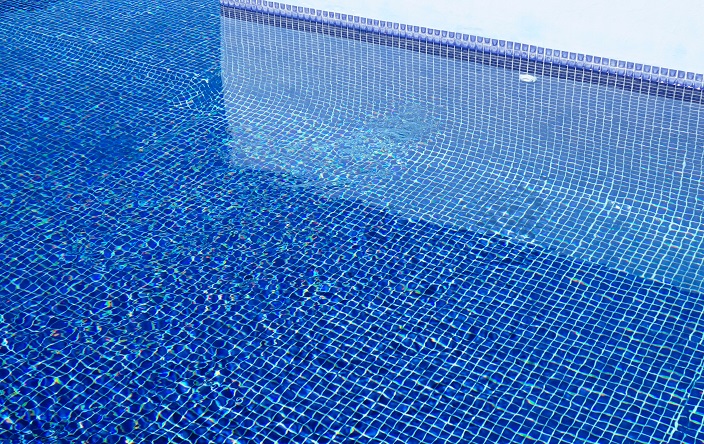
8. Final Steps
At the end of the entire process, the water in the pool must be chemically treated. This helps to improve the look and longevity of the new pool surface material. Also, once the pool has been filled with water, it needs to undergo multiple procedures to allow the surface to cure evenly.
Regular monitoring and supervision are necessary during the first week of the curing process. After this is done successfully, you should have a new and shiny pool in which to frolic.
Can I Do It Myself?
As mentioned at the very beginning, pool resurfacing is a task that is best left to the professionals. Water is not a forgiving medium, and one single misstep can lead to the entire project requiring a do-over. So to avoid such hassles, it’s recommended to leave the job in the hands of the experts.
Conclusion
Resurfacing is one of the prime requirements for maintaining a safe and healthy pool. And Valley Pool Plaster is your best choice for all pool resurfacing jobs! Our experts are adept at handling all types of pool resurfacing and can undertake the task for all sizes of pools.
So just leave it to us, and prepare for a swim!
